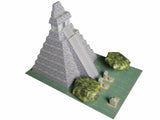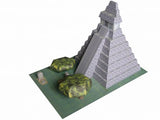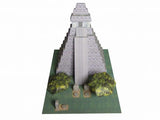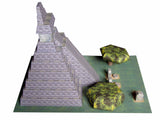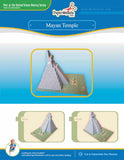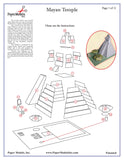Mayan Temple - Paper Model Project Kit
🌟 Welcome to Paper Models Online – Your Shortcut to Academic Excellence! 🌟
Are you tired of stressing over last-minute school projects? Look no further! Paper Models Online is here to make your academic life a breeze.
🚀 Why Choose Us?
At Paper Models Online, we understand the pressure of looming deadlines and the desire for that coveted "A" grade. That's why we've crafted the perfect solution for you! Whether you're a student aiming for extra credit, a parent looking for quality time with your kids, or just someone in need of a break from the chaos, our paper models are your ticket to success!
💻 Instant PDF Download OR Pre-Printed & Shipped
You're in control! Choose from our instant PDF download, starting at just $9.95 for the 7"x10" size or $11.95 for the 10"x13" size.
Print it on your home or office printer using regular paper, or opt for the hassle-free pre-printed option. We'll ship it directly to your doorstep for a flat $5 fee via USPS First-Class Parcel, ensuring you get it in 1-3 days!
✂️ Easy Assembly, Maximum Impact
With just a pair of scissors, some glue, and an hour of your time, you can turn these paper sheets into stunning three-dimensional architectural replicas or complete science projects. The images on our website are real models made from our kits, and we even provide a history to help you craft an impressive report.
🎨 Unleash Your Creativity
Not into mission kits? No worries! Our models double as templates for your creative genius. Paint, trace, adjust sizes—your imagination is the only limit! Create a custom masterpiece that reflects your unique style and personality.
🛒 The Buying Process Made Simple
- Choose Your Size: 7"x10" or 10"x13"
- Choose Your Delivery: Instant PDF download or pre-printed and shipped
- Purchase Your Model: It's that easy!

📦 Typical Kit Sample
Each kit includes 8 to 18 pages, providing everything you need to bring the model to life. An "exploded view" guides you through assembly, and a complimentary history adds that extra touch for your report. Impress your teacher not just with creativity but also with your research skills!
Don't let deadlines stress you out. Choose Paper Models Online for your next school project, and let us be Your Best Way To Get An "A"! 🌟
 |
 |
 |
| Exploded View | Sample Pieces | Finished Model |
Free History For Your Report
Mayan Temples
The Mayan Civilization was a pre-Columbian people in Mesoamerica, and is most noted today for having incredible art and architecture as well as the only fully-developed written language in the time period. Primarily occupying the area of current-day central Mexico and Latin America, the Mayan civilization developed around 250 BCE and thrived until the arrival of Spanish colonists; their densely-populated civilization vanished shortly after. One of the most famous Mayan sites today is in the city of Palenque, in the state of Chiapas, Mexico. Palenque was not as large as other Mayan cities, such as Tikal, Guatemala, or Copan, Honduras, but the architectural integrity of the ruins found here far surpasses that of any other location.
Four ancient Mayan temples, which have become the main icon of the Mayan people, are found in the main part of Palenque, and include the Temple of Inscriptions, as well as the Temple of the Cross complex, which comprise of Temple of the Cross, Temple of the Sun, and Temple of the Foliated Cross. The Temple of Inscriptions, one of the largest Mayan temples and begun around 675, tells the story of the culture’s history and Palenque’s main deity, the trinity of the Palenque Triad. This is done through iconic art and the language of hieroglyphics. This second-largest assembly of Mayan hieroglyphics (second only to Copan’s Hieroglyphic Stairway) also records the important rituals of the city’s leader, K’inich Janaab’ Pakal, especially due to the fact that this large temple also serves as Pakal’s tomb. A passageway inside the temple, once concealed by the Mayans and re- opened by archeologists, led to the discovery of Pakal’s tomb chamber, as well as what is called a psychoduct – a small opening from the tomb chamber to the outside of the temple. This psychoduct is said to have aided the release of the soul from the structure after one’s death, and would be keeping with Mayan cultural traditions and beliefs regarding death.
The other three temples, like the Temple of Inscriptions, all sit atop large step pyramids, which were constructed to serve as funeral monuments and to aid in sacrifices to the gods. Their heightened elevation was both to gain closer access to the gods and to raise the significance of the temples among the other buildings in the city. Each temple was often decorated with intricate bas-reliefs, each corresponding to a particular reason or individual to whom that temple was built. The three Temple of the Cross structures featured bas- reliefs of figures holding ritual instruments and making sacrifices, while the nearby Aqueduct Pyramid features a bas-relief of The God of Death.
Little attention was paid to the Mayan temples and pyramids ever since their abandonment by the native civilizations. Other than being random points of interests for tourists, even the archeological community gave little heed. This changed in 1949 when archaeologist Alberto Ruz Lhuillier was commissioned by Mexico’s National Institute of Anthropology and History to excavate and explore the site. The work de-escalated in the early 1950’s, and again was abandoned until Mayan descendents successfully persuaded further study on the culture and the pyramids, mostly focusing on Palenque. While work has continued at a rapid pace since then, experts estimate that the ancient city has only been 5% excavated, and there is still a great deal more to learn about the culture, temples, and great pyramids of the Mayan people.
© Copyright – Paper Models, Inc. – All Rights Reserved







